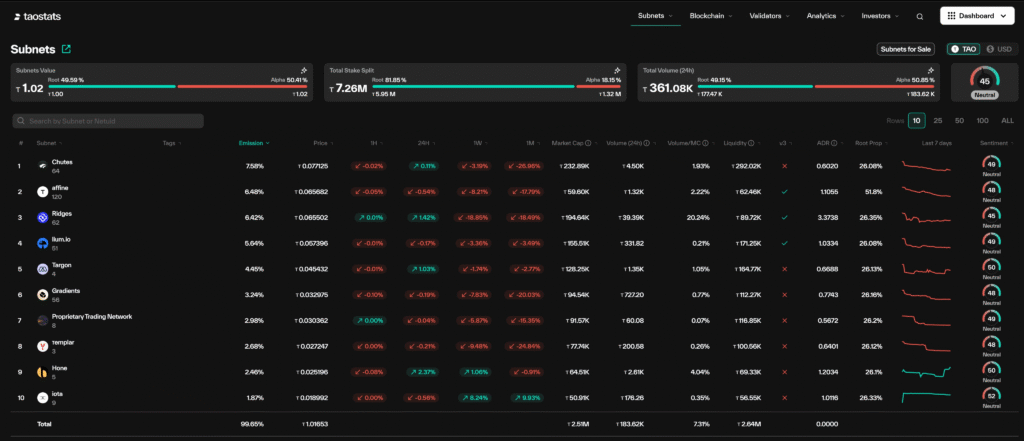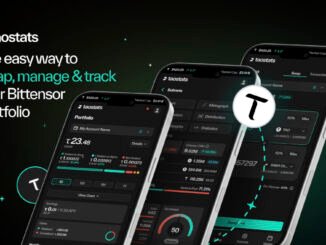
Note: Full article by hitesh.eth.
this is a deep dive into bittensor and why it is not a decentralized openai but a decentralized ai economy. it explains how dTAO reshaped its incentive design, how subnet economics work, and why tao represents cultural resistance to centralized ai.
what changed after dTAO?
many people like me always had this thought, what exactly bittensor is trying to achieve. are they trying to build a decentralized OpenAI or is there something more to it. we actually formed this consensus in the crypto community that maybe they are a decentralized OpenAI, but then people got confused when they removed subnet limits and made it more competitive when they introduced dTAO, which also involved subnet tokens. this shift was crucial because it moved the network’s reward allocation away from the centralized voting of a few high-stake root validators to a purely market-driven system.
the introduction of dynamic tao (dTAO) fundamentally changed the ecosystem’s mechanics. the power to allocate the daily tao emission shifted entirely from the root validators (subnet 0), which critics called an oligarchic voting system, to the market price of each subnet’s alpha token. every mining subnet gained its own alpha (α) token and its own AMM pool where α trades against τ. this meant every subnet could develop an independent, capital-driven economy. staking changed from delegating tao to a single validator (subnet 0 staking) to buying and staking the subnet-specific alpha token (α). stakers now assume market risk but gain direct influence over resource allocation. the old, rigid 50/50 reward split between miners and validators evolved into the current 41/41/18 split, intentionally reallocating tao to better fund subnet owners (18 percent) and incentivize continuous innovation of the subnet’s core incentive mechanism.
the grand vision
now when i look at bittensor, i simply see they are competing against centralized AI development and distribution by providing an infra for devs to build different AI use cases for different industries. this distinction is critical to understanding bittensor’s total addressable market (TAM). while companies like openAI compete in the immediate, multi-billion-dollar market of selling finished ai products like subscriptions or api access, bittensor is aiming for the multi-trillion-dollar market of the entire ai value chain – the computational infrastructure, the data validation, the model training, and the peer-reviewed intelligence layer.
if successful, bittensor’s TAM as the foundational, permissionless platform for all decentralized AI is inherently far larger than that of any single proprietary AI company. they are working and deploying different AI models, building a coordination engine for a distributed and decentralized AI ecosystem while motivating people to provide capital and computing resources to achieve the highest level of quality, efficiency, and trust in outcomes across decentralized AI projects working on different use cases. it is more like building a decentralized AI value chain where anyone can become a part of it with capital, knowledge, and computing.
bittensor is for everyone, not for that 0.000001% in the world who can think about getting involved with openai in any way.
the whole vision of bittensor is to build a neural internet, and they have built a loyal community over the past 4 years that believes in this vision. the bittensor community involves top vcs like DCG, top crypto researchers like sami kasab, and many giga brains who are working every day to push the vision forward.
they are making content, doing podcasts, building products, and running a movement now. bittensor has also managed to build a growing ecosystem of subnets. around 126 subnets are live now. the current subnet cost is around 1600 tao ($640k) and this cost is dynamic, changing constantly based on the frequency of new subnet registrations. new subnet registration are live again after a long few months pause.
one of the earliest bitcoin pioneers, barry silbert, who launched grayscale in 2013 with the idea of getting institutional interest around btc back then, is now building a similar fund for subnet tokens. they announced a 10m dollar fund called the yuma subnet composite fund which could allocate investments across top subnet tokens by market cap.
subnet tokens
subnet tokens are one of the most slept-on assets in crypto twitter right now. 99 percent of crypto twitter is clueless about this side of crypto where they could speculate based on which subnets will attract more tao emissions, which subnets miners would prefer to mine to get more rewards, and so on.
the core idea about subnet token price is that it is denominated in tao, not simply pegged, and is determined by the liquidity ratio in its automated market maker (AMM) pool. the more a subnet token is valued against tao, the more emissions it gets. more emissions invite more miners to host and run ai models and provide computing resources. miners compete against each other to optimize subnet model outputs, and there is a financial incentive to do that. better results always lead to higher price, or more precisely, better service attracts more staking demand which leads to higher price, ensuring overall quality in outputs across ai models being used by different subnets for different use cases. validators make sure miners maintain quality.
their job is to validate miner work and assign them a score. based on that score, miners get emissions from subnets. around 7200 tao is issued daily, and that amount will be cut in half in the next 2 months as the first bittensor halving event takes place in december.

that means there is immense competition right now in the mining ecosystem to accrue maximum rewards. most miners will stick to top-performing subnets, and if they mine top subnets, the price of those subnet tokens will also increase. more mining demand driven by high emissions always results in higher subnet token price. the initial demand to mine any subnet usually comes from speculation around the use case they are building, the team behind it, their past track record, and backing from big players.
right now, the top subnet tokens with the highest emissions are chutes, ridges, gradient and others. some of these subnets are funded by vcs too, like gradient which is building the ai trains platform. it is built by rayon labs, who also run the leading subnet by emissions called chutes, which offers serverless compute, powering trillions of tokens every month. many of these subnets are coordinating with each other to exchange services. for example, ridges is a client of chutes. you will also find interesting subnets like sportstensor which are building ai models for sports betting and prediction, and subnets like openkaito which powers the infofi pioneer by kaito. taofi is also an interesting part of bittensor. they launched a dex that allows you to bridge and swap subnet tokens easily from the base network.
believe in TAO
now if you ask me which subnet tokens will attract demand, i think you need to track growth in subnet token price against tao. the more you see growth on different timeframes, the more demand is rising. then you need to check adr (alpha distribution ratio). it should be less than 1 because now deregistration is open. the least-performing subnets will get deregistered every week. if the adr ratio is above 1, the community could lose a portion of the value of the tao collateral they staked to get that token due to a liquidation haircut upon deregistration.

you can also track staking pools of different subnets. the more tao being staked to get subnet tokens, the more likely price will follow. so i think subnet tokens are more about how long they can attract higher emissions. if they keep getting high emissions and if the business around the subnet makes revenue from services and products they offer, then subnet tokens could keep rising in price. the overall capitalization growth around subnets will directly push tao price higher.
but again, i would suggest staying away from things you do not understand. subnet tokens are not like regular alts or shitcoins. they require deeper logical understanding, so it is better to invest in tao if you believe in their vision. tao is a coin you believe in. it is not something to trade. it is a cultural symbol of the fight against the centralization of ai.
the question is not whether decentralized ai will exist. the question is who will own it. bittensor has already made its choice. so will everyone else.




Be the first to comment